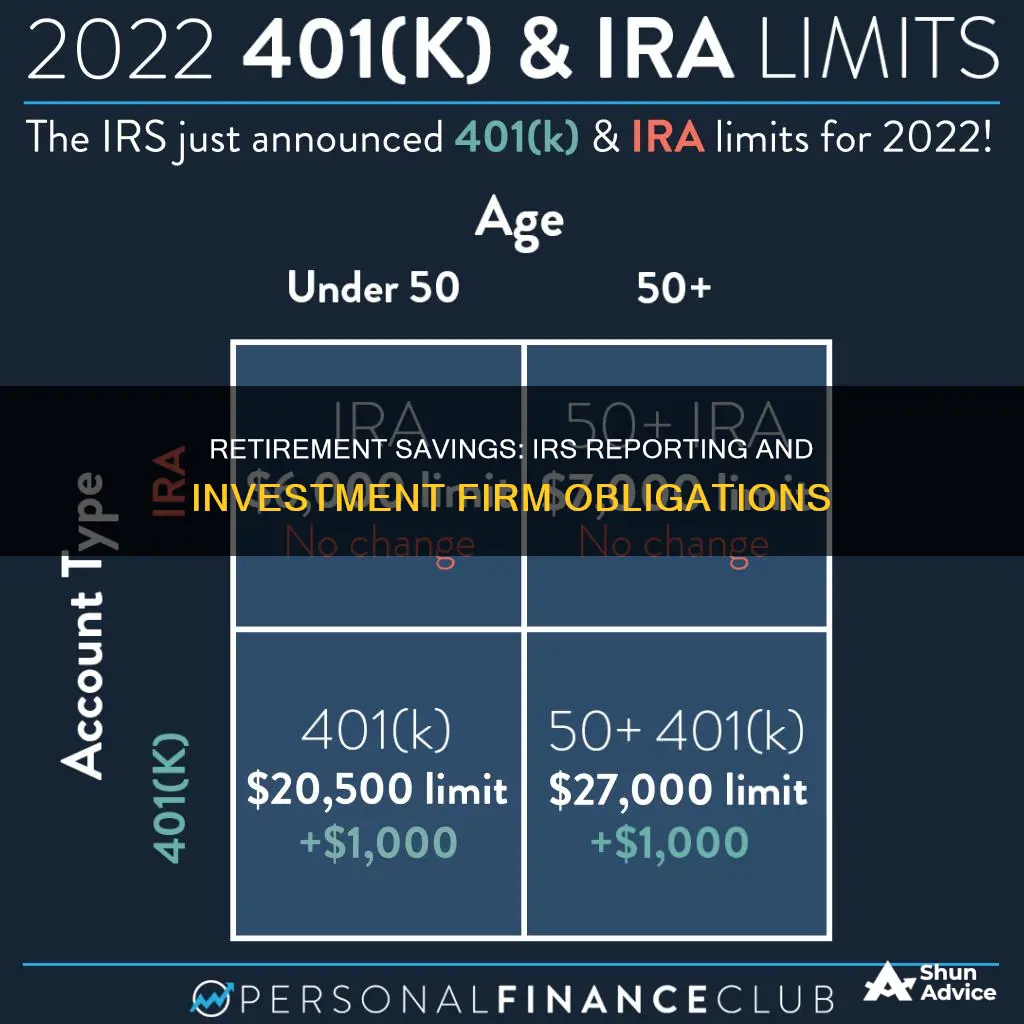
Retirement plans and investment firms have certain reporting requirements that they must adhere to when it comes to disclosing information to the IRS. These requirements can vary depending on the type of plan and its specific circumstances. For example, different forms are needed for reporting on retirement plans, such as Form 5500 for an annual return or report of an employee benefit plan, and Form 5330 for excise tax returns. In the case of an individual retirement arrangement (IRA), there are also specific forms to be used, such as Form 1099-R for distributions of $10 or more, and Form 5498 for reporting IRA contributions. It is important to note that while contributions to certain plans, such as 401(k)s, are typically not considered taxable income and do not need to be reported on a tax return, any distributions from these plans are legally required to be reported as they are considered ordinary income.
What You'll Learn

Reporting requirements for different retirement plans
Reporting requirements for retirement plans vary depending on the type of plan, its size, and its circumstances. Here is a summary of the reporting requirements for different types of retirement plans:
Individual Retirement Arrangements (IRAs)
IRAs are tax-favored personal savings arrangements that allow individuals to set aside money for retirement. There are two main types: traditional IRAs and Roth IRAs. Reporting requirements for IRAs include:
- Deductible contributions to a traditional IRA can be deducted from taxable income.
- Nondeductible contributions to a traditional IRA must be reported using Form 8606.
- Distributions from a traditional IRA are fully or partially taxable and reported using Form 1099-R.
- Conversions from a traditional IRA to a Roth IRA are reported.
- Distributions made before the age of 59½ may be subject to an additional 10% tax, reported on Form 5329.
- Failing to withdraw minimum distributions by the required date may result in an excise tax, also reported on Form 5329.
Defined Benefit (DB) and Defined Contribution (DC) Plans
These plans have specific reporting requirements, including:
- Qualified Joint and Survivor Annuity (QJSA) and Qualified Preretirement Survivor Annuity (QPSA) notices must be provided to participants before the annuity starting date.
- Domestic Relations Order and Qualified Domestic Relations Order (QDRO) notices must be provided to inform participants of the plan's procedures.
- Notice of Right to Diversify Investments must be provided to applicable individuals.
- 401(k) and 401(m) Safe Harbor notices must be provided annually and to new eligible employees.
- Notice of Effective Opportunity to Make or Change Cash or Deferral Election must be provided annually and to new eligible employees.
- Various other notices, such as Qualified Automatic Contribution Arrangement (QACA) notices, must be provided as applicable.
Foreign Retirement Plans
Individuals with foreign retirement plans may need to report them on specific information reporting forms, depending on the type of plan and its structure. Common forms include:
- Report of Foreign Bank and Financial Accounts (FBAR): Required when foreign bank accounts have an aggregate high balance of $10,000 or more during the tax year.
- Form 8938: Used to report various "specified foreign assets," including foreign accounts, contracts, and interests in foreign entities. The reporting threshold varies depending on the individual's filing status and residence.
- Form 3520: Used to report interests in foreign trusts, gifts, and estates. It may also be required for certain foreign retirement plans viewed as foreign trusts.
Form 5500 Series
Retirement plans may also need to file various forms from the Form 5500 series, including:
- Form 5500: Annual Return/Report of Employee Benefit Plan, providing information on the plan's qualification, financial condition, and operation.
- Form 5500-EZ: Annual Return for one-participant retirement plans or foreign plans.
- Form 5500-SF: Short Form Annual Return for small pension and welfare benefit plans with fewer than 100 participants.
- Form 5558: Application for an extension of time to file certain employee plan returns.
Investments: Spend, Save, or Grow?
You may want to see also

IRA contribution limits
The contribution limits for IRAs depend on the type of IRA you have, your age, and your income.
Roth IRA Contribution Limits
For 2024, the contribution limit for a Roth IRA is $7,000 for those under 50, and $8,000 for those 50 or older. This is an increase from 2023, when the contribution limit was $6,500 for those under 50, and $7,500 for those 50 or older.
The cap applies to contributions made across all IRAs you might have. For example, if you have both a Roth IRA and a traditional IRA, the combined contributions can't exceed $7,000 for those under 50, or $8,000 for those 50 or older in 2024.
Income Limits for Roth IRA Contributions
Your tax-filing status and modified adjusted gross income (MAGI) determine how much money you can put into a Roth IRA.
For 2024, if your MAGI is less than $146,000 and you're a single filer (or less than $230,000 for those married filing jointly), you can contribute the full amount.
If your MAGI is between $146,000 and $161,000 as a single filer, or between $230,000 and $240,000 if you're married filing jointly, your contribution is reduced. If your MAGI is higher than $161,000 for single filers or $240,000 for those married filing jointly, you are not eligible to contribute.
Traditional IRA Contribution Limits
The maximum combined amount you may contribute annually across all traditional IRAs is the same as for Roth IRAs: $7,000 for those under 50, and $8,000 for those 50 or older.
However, unlike Roth IRAs, traditional IRA deduction limits are based on your MAGI, tax-filing status, and whether you or your spouse are covered by a retirement plan at work.
For 2024, if you are covered by a retirement plan at work and your MAGI is higher than $77,000 but less than $87,000, you can make a partial deduction. If your MAGI is higher than $123,000 but less than $143,000 and you are married filing joint returns, you can also make a partial deduction.
If you are not covered by a retirement plan at work, you can make a full deduction up to the amount of your contribution limit, regardless of your MAGI or tax-filing status.
Investing: Control, Returns, and Excitement
You may want to see also

Tax-deductible contributions
Contributions to a traditional IRA may be tax-deductible. The deduction may be limited if you or your spouse is covered by a retirement plan at work and your income exceeds certain levels. If neither you nor your spouse is covered by a retirement plan at work, your deduction is allowed in full.
The amount you can deduct depends on your modified adjusted gross income (MAGI) and whether or not you're covered by a retirement plan at work. If you (and your spouse, if applicable) aren't covered by an employer retirement plan, your traditional IRA contributions are fully tax-deductible. If you (or your spouse, if applicable) are covered by an employer retirement plan, you can still make contributions to a traditional IRA, but they may qualify as partially tax-deductible or totally non-tax-deductible, depending on your income.
The limits on the amount you can deduct don't affect the annual amount you can contribute. However, you can never claim a tax deduction for more than what you contributed to your IRA that year.
To figure out your allowable deduction, you can use the worksheets in the Instructions for Form 1040 (and Form 1040-SR) PDF or in Publication 590-A, Contributions to Individual Retirement Arrangements (IRAs). You can then claim your IRA deduction on Form 1040, U.S. Individual Income Tax Return or Form 1040-SR, U.S. Tax Return for Seniors (attach Schedule 1 (Form 1040), Additional Income and Adjustments to Income PDF).
If you made nondeductible contributions to a traditional IRA, you must attach Form 8606, Nondeductible IRAs. You can use Form 8880, Credit for Qualified Retirement Savings Contributions, to determine whether you're also eligible for a tax credit. Enter the amount of the credit on Form 1040 or Form 1040-SR (attach Schedule 3 (Form 1040), Additional Credits and Payments PDF).
Checks for Investments: When to Write
You may want to see also

Reporting rollovers and transfers
A rollover occurs when you withdraw cash or other assets from one eligible retirement plan and contribute all or part of it, within 60 days, to another eligible retirement plan. This rollover transaction is reportable on your federal tax return.
There are three types of rollovers: direct, trustee-to-trustee, and 60-day. A direct rollover involves asking your plan administrator to make the payment directly to another retirement plan or IRA. No taxes are withheld from the transfer amount. A trustee-to-trustee transfer involves asking the financial institution holding your IRA to make the payment directly from your IRA to another IRA or retirement plan. Again, no taxes are withheld from the transfer amount. A 60-day rollover occurs when a distribution from an IRA or retirement plan is paid directly to you, and you then deposit all or a portion of it in an IRA or retirement plan within 60 days. Taxes will be withheld from a distribution from a retirement plan, so you will need to use other funds to roll over the full amount.
When deciding whether to report a rollover or transfer on your tax return, you will need to consider the type of retirement plan the distribution was made from and moved to (e.g. traditional IRA, Roth IRA, qualified employee plan other than a designated Roth account). You may need to check with your IRA trustee or retirement plan administrator to determine the account type. You will also need to determine whether you have a cost basis to recover. Your cost basis consists of previously taxed amounts, including nondeductible IRA contributions or after-tax contributions made to an employee retirement plan.
If the assets were not moved directly from one account to another, you will also need to know the number of days between the date the distribution was taken from one account and deposited into the other, whether a previous tax-free rollover occurred within 12 months of the distribution, and whether federal income tax was withheld from the distribution (Form 1099-R).
Rights: A CMO Investor's Guide
You may want to see also

Early withdrawals and penalties
Early withdrawals from retirement plans are generally subject to income tax and may incur an additional 10% tax penalty. This applies to most withdrawals from an IRA or retirement plan before the individual reaches the age of 59 1/2. These are called "early" or "premature" distributions.
There are, however, several exceptions to the 10% additional tax penalty. These include:
- Permissive withdrawals from a plan with auto-enrolment features.
- Distributions of up to $5,000 per child for qualified birth or adoption expenses.
- Corrective distributions of excess contributions, made in a timely manner.
- Total and permanent disability of the participant/IRA owner.
- Disaster recovery distribution of up to $22,000 for qualified individuals who suffer economic loss due to a federally declared disaster.
- Domestic abuse victim distribution of up to $10,000 or 50% of the account (whichever is lower) for those who self-certify as a victim of domestic abuse.
- Qualified higher education expenses.
- Emergency personal expenses of up to $1,000 or the vested account balance (whichever is lower) for one distribution per calendar year.
- Unreimbursed medical expenses exceeding 7.5% of AGI.
- Health insurance premiums paid while unemployed.
- Certain distributions to qualified military reservists called to active duty.
- Returned IRA contributions, if withdrawn by the extended due date of return, excluding earnings on these contributions.
- In-plan Roth rollovers or eligible distributions contributed to another retirement plan or IRA within 60 days.
- Separation from service during or after the year the employee reaches age 55 (or 50 for public safety employees, including federal law enforcement, federal firefighting, customs, border protection, or air traffic control).
- Distributions to a terminally ill employee, certified by a physician.
- Distributions equal to the amount paid for family health insurance by an individual who was unemployed for 12 weeks and received unemployment compensation in the year of the distribution or the subsequent year.
Converting a 401(k) to an IRA could be a way to keep your funds and avoid the early distribution penalty. IRAs have slightly different withdrawal rules, and there is no mandatory withholding on IRA withdrawals, meaning you may be able to receive a bigger check now (although you will still have to pay tax when you file your tax return).
Real Estate: Why the Hesitation?
You may want to see also
Frequently asked questions
Yes, investment firms are required to report retirement contributions to the IRS. This is done through various forms, such as Form 5498 for IRA contributions and Form 1099-R for distributions from profit-sharing or retirement plans.
There are several types of retirement plans that can be reported, including traditional IRAs, Roth IRAs, 401(k) plans, SEP IRAs, and SIMPLE IRAs. Each plan has different contribution limits and tax implications.
Yes, there are certain instances where you may not need to report retirement contributions. For example, if you are simply making contributions to a 401(k) plan or rolling over the plan to another account, it is generally not considered taxable income and does not need to be reported.







